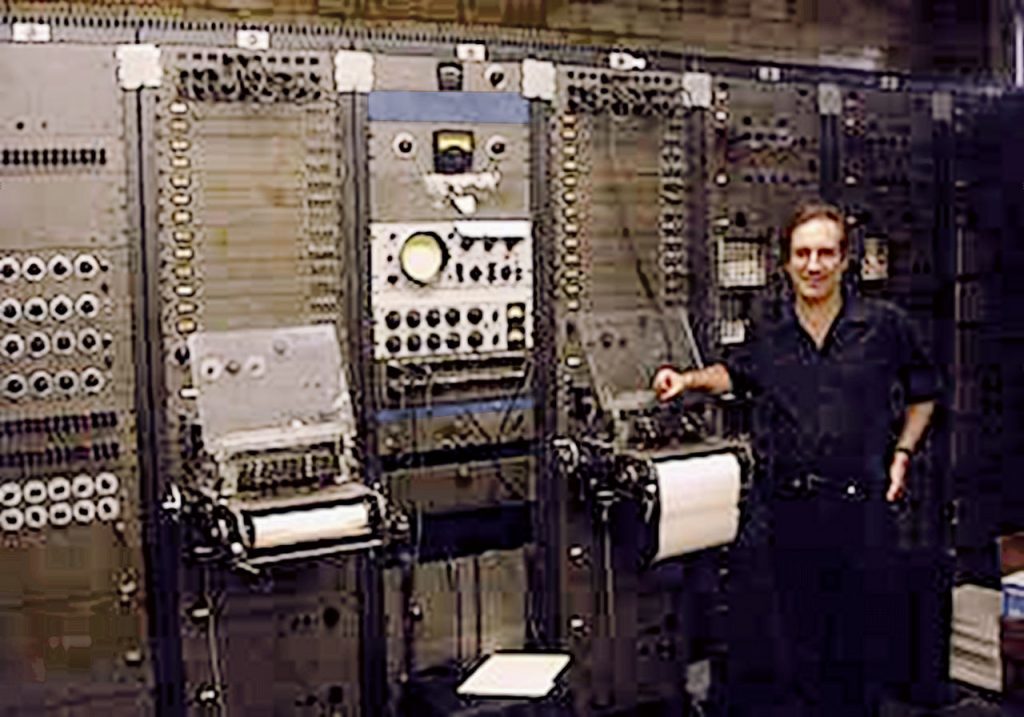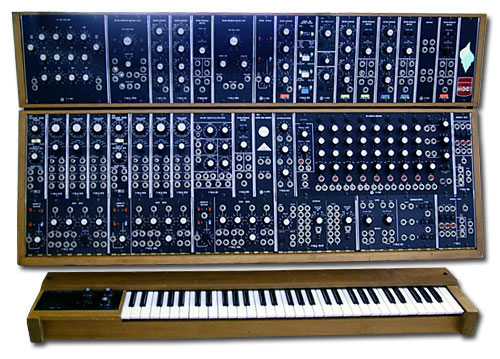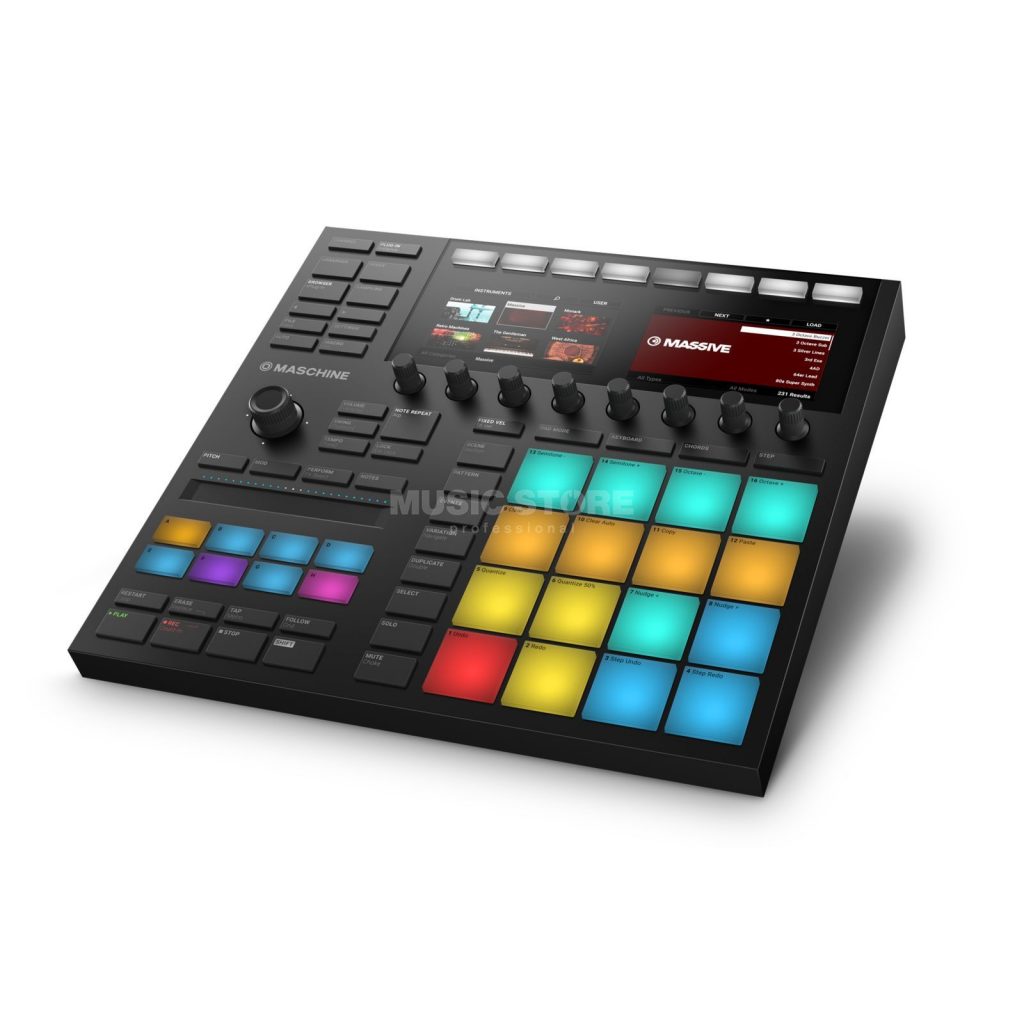(Original text language – English)
In general, the synthesiser is an electronic musical instrument that generates audio signals. This is very simplified definition but gives back the idea of this device. Important fact is, that for the first time in music history appeared an instrument that potentially can produce any kind of sound. Or noise. Or both. It can imitate any existing traditional instrument but can produce new, unique and sometimes very strange sound. The sentence “sky is the limit” could not fit better to this device. Synthesisers are limitless in terms of sound creation.
INITIAL PERIOD 1960 – 1980
This large group of musical instruments conquered the music scene in 70′ last century, however synthesisers appeared a decade or so earlier – on the beginning of 60′. There were instruments that produced sound by electric circuit even before, but mostly as an effect of the scientific researches on electro-acoustic problems in academic laboratories.
First synthesisers were big, heavy and very difficult to manipulate. They easily occupied whole room and the sound was created by inserting perforated cardboards.
Here RCA MARKII (1957) source: https://en.wikipedia.org/wiki/RCA_Mark_II_Sound_Synthesizer

The first fully commercialised synth was invented by the scientist engineer Robert Moog in 1964 and first exemplars sold in 1965. The specify of this synthesiser is its modular nature. The synthesiser is build on modules that can be configured on individual demand of one who orders this instrument. There are however elements/modules that appear always in any configuration of the synth. In fact, those elements are until today present in all synthesisers – no matter – physical or virtual/software ones. More about this in a moment.

Moog System55 (Photo source: Wikipedia).
Without doubts it was a revolutionary instrument, but the price made this synth affordable only for few musicians, groups or studios. In the 1971 median annual family income oscillated of $10,290 according to official US statistics. The price for the complete unit of Moog was around $10,000.
On the beginning the music communities were very sceptical about these new instruments. Only experimentalists and extravagant creators welcomed this innovation with open arms. “Music concrete” composers often searched for cacaphonic, weird and never heard before sound creations.
How difficult to sell this new product, it is enough to say that the constructors were directly involved in the promotion of their products visiting music shops across the country trying to attract potential buyers with their offer. And they didn’t always succeed. And the synthesisers themselves with unpredictable sounds and behaviour, going out of tune, requiring a lot of technical knowledge were far from ideal instruments.
A great role in the promotion of this synth played Wendy Carlos (Walter Carlos) when published her album made on programmed Moog: “Switched-on Bach” – electronic versions of popular classic composer. According to Carlos, Switched-On Bach took approximately five months and one thousand hours to produce. Notes had to be programmed manually, were recorded on the magnetic tape. Oscillators of the synth continuously went out of tune and had to be tuned every few notes. Album contains 10 tracks. This artwork however became a success. After wikipedia: “Switched-On Bach reached number 10 on the US Billboard200 chart and topped the Billboard Classical Albums chart from 1969 to 1972. By June 1974, it had sold over one million copies, and in 1986 became the second classical album to be certified platinum. In 1970, it won Grammy Awards for Best Classical Album, Best Classical Performance – Instrumental Soloist or Soloists (With or without Orchestra), and Best Engineered Classical Recording”.
It appears that using synthesisers for classical music re-creation is still sort of controversial by some listeners.
The picture to that period of synth development would not be complete without mention another engineer – Don Buchla. When Robert Moog was creating his modular synth in New York, on the West US coast in California Don Buchla created his first modular synth more or less at the same time. There is no evidence that one copied another or they in any way were associated. Although the idea of modules in building the synthesiser is the same, there are differences between those two systems.
Not much time later – in 1971 Alan R. Pearlman and his team offered brand new ARP2600. Probably the first portable synthesiser made. The concept of this instrument came after the first project of ARP2500 which in its shape and size was similar to Moog instrument. Pearlman’s idea was to create universal instrument for musicians, studios but also for education aiming the colleges, music schools and high schools. In the period of 10 years (1971-1980) only about 3,000 units were manufactured, but until today this synth is probably most iconic and desirable synthesiser ever made. The initial price in the first year of production (1971) was 2600 USD. Today the rarely found second hand units reach the price well over 10,000 USD. Like the other synths of this era it was monophonic (single voice) instrument with three oscillators and classified as semi-modular, which means that some connections of the modules/sections were pre-wired and no cables were needed to initiate the sound. It has also the keyboard attached, which was not so obvious in that time, when each sound was separately created and tuned manually.

ARP2600 (Photo source: Wikipedia)
This model became highly demanded by many composers of almost every genre of music. Jazz, rock, neo-classical music, experimental “music concrete”, to name just few. Also great names in music history were associated to this synth: Stevie Wonder, Herbie Hancock, Jean-Michel Jarre, Tangerine Dream, Klaus Schulze, but also Rolling Stones, Queen, Pink Floyd and maybe most recognisable user of this instrument – synth-pop band Depeche Mode – among many others.
Before we continue our journey on history of synthesisers – I own the reader one remark. I present only a milestone gear or the gear that made a greatest impact on synthesisers’ development. Of course there were more producers and models that appeared on the market. And big actors like KORG, YAMAHA, CASIO, ROLAND, OBERHEIM, SEQUENTIAL CIRCUITS and many others also pretended to their piece of cake (market).
TURN OF SEVENTIES AND EIGHTIES
Four important (and revolutionary) things happened in the period – late 70′ and primary 80′:
- polyphony
- digital synthesisers
- samplers
- MIDI standard
Until end of 70′ synthesisers could play only one note (one sound) at the time. An American engineer Tom Oberheim invented first polyphonic synthesiser – “Oberheim OB-X” in June 1979. After 800 units manufactured it was replaced by its successor “Oberheim OB-Xa” in 1981. The first models of OB-X were priced on over 4,500 USD and had 4, 6 or 8 voices polyphony what means that at the same time 4, 6 or 8 keys or voices could be produced. On top of that the tune of the keys was improved and memory for 32 user programmable presets added (a big step forward comparing to older monophonic synths where each time the sound had to be adjusted by the player).
The most famous riff of this synth you can hear in Van Halen’s song “Jump”.

Oberheim OB-X (Photo source: Wikipedia).
Another big milestone step was made by the Japanese company YAMAHA which was the competitor on the synth marked since years already. Its synthesiser YAMAHA DX7 again revolutionised the synthesisers’ world. And it was the first commercially seccessful digital synthesiser.
Before it happened, the company was investigating the FM (frequency modulation) synthesis in deep, which was originally developed by John M. Chowning back in 1967. This close cooperation between Chowning and Yamaha resulted with succesfully manufactured Yamaha DX7 in 1983. Yamaha licensed the technology to create the DX7, combining it with very-large-scale integration chips to lower manufacturing costs. Interesting fact is that due to the complex menus and lack of conventional controls only few of the instrument users were able to dig deep into instrument’s capabilities. Anyway, the factory presets became immediately recognisable in many 80′ productions. And the instrument became an icon of 80′ music.
Yamaha DX7:

Yamaha had hoped to sell around 20,000 units in 1983. Within one year the orders exceeded 150,000 units and the sell during first three years reached 200,000 units. And not only this. In 1986, it was used in 40% of the number-one singles on the US Billboard Hot100 list. Most of the top artists and bands were using this instrument like A-HA, Whitney Houston, Phill Collins, Billy Ocean, Celine Dion, U2 and Coldplay to mention just few. It would not be prejudged saying that 80′ are equal to Yamaha DX7 in the context of synthesisers’ use in pop music.
Samplers is a separate group of musically useful devices. According to the definition, sampler is a musical instrument that records and plays back samples (portions of sound recordings) – following the wikipedia description. It can be human voice, industrial, nature or any other sound recorded, any audio event in general. Then it can be turned into the musical scale or in any other way processed and played back.
In the pre-computers’ and pre-samplers’ era the way of store, process and play back sounds was to record them on the magnetic tape. The tape was then cut, limed again and played as a set of combined voices or sounds together or as one voice recorded with different speed. This process was time consuming and difficult to achieve demanded results.
Although the early samplers were invented in 70′, the price was far beyond most people’s range with the costs over 30,000 USD. the situation changed in mid-80′ when E-Mu Emulator came into the market with initial price around 10,000 USD or below in 1981. E-Mu Emulator was equipped with 5,25″ floppy disc that enabled the musician to sample sounds, recording them to storage media and allowing them to be played as musical notes on the keyboard. The 5,25″ floppy disk drive enabled the owner to build a library of samples and share them with others, or to purchase prerecorded libraries on disk.
Approximately 500 units were sold before the unit was discontinued in early 1984. Among the prominent users of the original E-mu Emulator were Stevie Wonder, New Order, Tangerine Dream and Genesis, and it was among the many groundbreaking instruments used in the production of Michael Jackson’s Thriller album. Vangelis had an Emulator at Demo Studios in London and used it on the Blade Runner Soundtrack.
E-Mu Emulator II (after Wikipedia):

Now-a-days samplers are the most popular sound devices. All the groove boxes, MIDI controllers are using this technique to produce the sound. Software based libraries contain thousands of samples that can be turned into the full chromatic scales or beats.

Native Instruments Maschine – Image from MusicStore.com
MIDI STANDARD
Before early 80′ instruments could communicate between each other by control voltage (VC). This method however was quite primitive and on top of that some synth producers used different standards within this method. For example – when many companies applied communication using Volt per octave, KORG and YAMAHA were using Hertz per octave. This did not exclude communication, which means instruments could still be connected but as a result, the sound from both instruments most probably was out of tune.
In 1981 the president of the ROLAND – Ikutaro Kakehashi initiated consultations with other big players on the electronic instruments’ market about standardisation of the instruments’ communication. SEQUENCIAL CIRCUIT president convinced other American producers, while Kakehashi discussed it with KORG, YAMAHA and KAWAI – Japanese companies. In early 1983 first time MIDI was officially presented on NAMM Show. The MIDI revolutionised music world and connects instruments and computers until today.
A MIDI which stands for Musical Instrument Digital Interface is a technical standard that describes a communication protocol, digital interface and electrical connectors that connect a wide variety of electronic musical instruments and computers and related audio devices for playing, editing, and recording music. In simple words it’s about a cable transmitted signal that provides the messages about all details of the signal event as pitch, gate and any other important aspect of the event that used to be played by the device. This protocol allows the communication between two MIDI devices to understand each other and react accordingly independently of the brand and kind of the device.
Many people, even musicians still misunderstand this standard, so important to remember is that this protocol does not transfer sound, but all information about it. From the note played, the pressure of hitting the key, time of sounding the note played, etc. This allows to play whole song on different instruments equipped with MIDI socket when once recorded as a set MIDI events.
Below the sample of MIDI visualisation is presented:

On the picture you can already see which note was played and the duration. When you connect any MIDI instrument, and apply the scheme above, the note and the duration of the note will be played exactly the same, no matter on which instrument. Sound however – will depend of the pattern chosen on each instrument. One physical connection may transfer up to 16 channels. MIDI protocol may contain 128 different messages (0…127).
Since popularisation of PCs in mid 80′ last century the development of electronic instruments is closely related to the improvement of the efficiency of processors, RAM, data transfer speed and storage capabilities of computers. If you compare music from video games made for Commodore64, Atari or similar – first popular computers – to the music made on computers now-a-days for Hollywood cinema productions you can have a picture.
I’m sure that this article only “scratches the surface” of what happened to the electronic music through the last 5 decades but at least it gives you a clue how it developed during that time.
